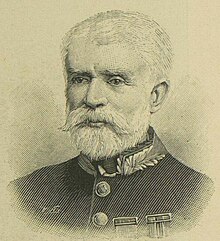Sir Alfred Biliotti | |
|---|---|
 Portrayed in the Illustrated London News, 1897 | |
| Born | 14 July 1833 |
| Died | 1 February 1915 (aged 81) |
| Citizenship | British (from 1871) |
| Spouse |
Marguerite (m. 1889) |
| Children | 1 (Emile) |
| Awards |
|
Sir Alfred Biliotti KCMG CB (14 July 1833 – 1 February 1915) was a Levantine Italian, born on Rhodes, who became a British consular official and amateur archaeologist. Biliotti probably received little formal education, and followed his father, who had carried out consular work for the governments of Britain, Spain and Tuscany, into the British consular service in 1849. He accompanied Charles Newton, an archaeologist then working for the British Foreign Service, on an archaeological tour in 1853, beginning a relationship of patronage by which Newton supported Biliotti in a twofold career, in the consulate and in archaeology.
After periods on Rhodes and at Trebizond, Biliotti was posted to Khania, the capital of Ottoman Crete, in 1885. There, he played a prominent role in the unrest and international interventions that marked the end of Ottoman rule, including the collapse of the Pact of Halepa in 1889 and the Cretan Revolt of 1897–1888. He reported the Lasithi massacres of 1897 and lobbied unsuccessfully for the pursuit and punishment of those responsible, investigated allegations of atrocities against both Christians and Muslims, and negotiated the evacuation of around 3,500 Muslims from a siege at Kandanos, gaining acclaim in the British press.
Biliotti acquired a dominant position in Cretan diplomatic circles, but was reassigned to Salonika in Thessaly in 1899, having gained the distrust of Prince George of Greece and figures in the British establishment, who accused him variously of sympathising with the Ottomans and of plotting against them. In Salonika, he again investigated alleged massacres of the Christian population. He retired on his seventieth birthday, in accordance with consular service regulations, in 1903.
Throughout his consular career, Biliotti carried out archaeological work, largely centred around the acquisition of objects for the British Museum. His excavations included, with Auguste Salzmann, the site of Kameiros on Rhodes, where he excavated over 300 graves of the archaic and classical periods; Ialysos, where he uncovered the first known examples of Mycenaean painted pottery; and the Roman legionary fortress at Satala near Trebizond. He also carried out minor archaeological work in Turkey and on Crete, and had a crocus, C. biliottii, named after him.
Biliotti was regarded as a competent and influential diplomat by contemporaries, and was frequently called upon by Lord Salisbury, the British prime minister, who had him knighted in 1896. He was friendly with Eleftherios Venizelos, later prime minister of Greece, and may have helped him flee Crete in 1889. His consular reports have widely been used by scholars of the period, though historians have also argued that Biliotti's negative view of Ottoman Muslims distorted his portrayal of them.